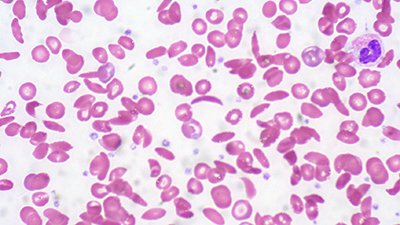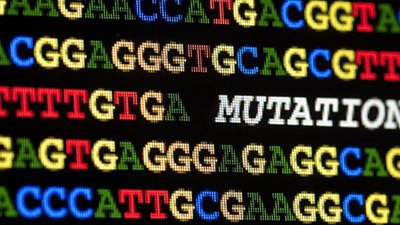
Can Accumulated Mutations Produce New Species?
Can three walk together and evolve into one?
News Source
- Science: “Three Snug Bugs”
Mealybugs—dubbed “wooly aphids” due to their rapacious appetites for plant sap—are setting symbiotic records. The citrus mealybug (Planococcus citri) hosts a bacterial symbiont (Tremblaya princeps) which has its own bacterial symbiont (Moranella endobia). The larger bacterium (T. princeps) has the smallest genome yet discovered. And these nested symbionts have a tag-team approach to metabolism which renders them completely interdependent.
The nesting-doll arrangement of these dual symbionts was discovered in 2001. Discoverer Carol D. von Dohlen and microbiologist John P. McCutcheon have teamed up to seek out the symbionts’ secrets. T. princeps has the smallest genome on record with only 121 genes. (Humans have 20,000 to 25,000.)
Neither bacterium could survive without the other. Each is missing some crucial genes. For instance, T. princeps is unable to make the transfer enzymes used to carry amino acids when proteins are being built.1 Thus their metabolic pathways crisscross, requiring the transfer of various molecules back and forth between the bacteria.
The metabolic network may also involve the mealybug. Aphids, like the mealybug, often have a symbiotic relationship with bacteria. The bacteria manufacture amino acids that the insect is unable to get from its sugary diet.
Many evolutionists accept the endosymbiotic theory developed by Lynn Margulis. They believe that protobacteria were consumed by other unicellular organisms but, instead of being digested, remained and became mitochondria and chloroplasts. These cellular organelles have some DNA of their own. Symbiogenesis adherents go on to explain that these protobacteria lost some genes over millions of years by transferring them to the host cell’s DNA. Thus two became one.
Evolutionary microbiologists are excited about the mealybug team because they believe they are seeing evolution in action—namely, the process by which symbionts transfer genes to each other as they merge to become one organism. “How bacteria become organelles is something we don't understand so well, because our only examples are millions of years old,” a protist expert in Vancouver commented. “This study . . . gives us an opportunity to look at how it's unfolding.”
Symbiogenesis, even from an evolutionary point of view, has problems. First of all, the original organisms would have to be already self-sufficient, not needing the merger to survive. Second, mechanisms would have to evolve to transfer cellular products from the main cell to the organelle before the proto-organelle could survive its gene loss, but until the genes were transferred to the host cell, there would be no survival advantage to cause selection of the new merger.
Her theory that evolution happens by mergers of organisms to create new ones puts her at odds with many mainstream evolutionists.
Incidentally, Dr. Margulis developed the theory of symbiogenesis because she does not believe that there is evidence mutations can accumulate to produce new species or that there is evidence of gradual changes in the fossil record. Her theory that evolution happens by mergers of organisms to create new ones puts her at odds with many mainstream evolutionists.
Nothing about these amazing new discoveries suggests or proves evolutionary symbiogenesis resulting in the formation of mitochondria and chloroplasts. Bacteria which lack sufficient genes to survive on their own may have been designed that way by God in the beginning, their role in the world being to enable other organisms to survive.
Alternatively, some symbiotic relationships may have developed after the Fall with its curse and some in the wake of post-Flood environmental changes. As Answers in Genesis molecular geneticist Dr. Georgia Purdom comments, “Gene loss within the endosymbiotic bacteria may have occurred (or may still be occurring) as a result of the formation of these new symbiotic relationships.”2
Creationists don’t deny that genomes and organisms can change. But like Dr. Margulis, we see no evidence that accumulated mutations can produce new species. As she says, “Natural selection eliminates and maybe maintains, but it doesn’t create.”3 Citrus mealybugs are still mealybugs, and these bacteria are still bacteria. Given the highly successful interdependence and the procreative propensities of their pesky landlord, they’ll likely continue to demonstrate the value of cooperation for us for years to come.
Further Reading
- Get Answers: Design in Nature
For More Information: Get Answers
Remember, if you see a news story that might merit some attention, let us know about it! (Note: if the story originates from the Associated Press, FOX News, MSNBC, the New York Times, or another major national media outlet, we will most likely have already heard about it.) And thanks to all of our readers who have submitted great news tips to us. If you didn’t catch all the latest News to Know, why not take a look to see what you’ve missed?
(Please note that links will take you directly to the source. Answers in Genesis is not responsible for content on the websites to which we refer. For more information, please see our Privacy Policy.)
Footnotes
- John P. McCutcheon and Carol D. von Dohlen, “An Interdependent Metabolic Patchwork in the Nested Symbiosis of Mealybugs,” Current Biology 21, no. 16 (August 23, 2011): 1366–1372, doi:10.1016/j.cub.2011.06.051.
- Georgia Purdom, “How Low Can You Go—Again?,” Answers in Genesis, April 19, 2011, https://answersingenesis.org/blogs/georgia-purdom/2011/04/19/evolutionist-challenges-mechanisms-of-natural-selection-and-mutation/.
- Ibid.
Recommended Resources

Answers in Genesis is an apologetics ministry, dedicated to helping Christians defend their faith and proclaim the good news of Jesus Christ.
- Customer Service 800.778.3390
- Available Monday–Friday | 9 AM–5 PM ET
- © 2025 Answers in Genesis




